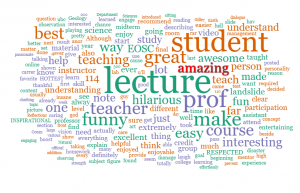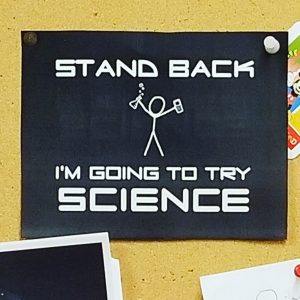“Brett is awesome….he is the reason why I decided to make a career out of Geology….”
Students review from ratemyprofessors.com
Last week I was observing my mentor, Dr. Brett Gilley, teaching an EOSC 114 class. This a large (~260 students) first-year level course at the department of earth and Ocean sciences where students being introduced to various Natural Disasters and how to prevent them. The topic of the lecture I was observing was Landslides.
I think one of the strengths of my mentor is the class management skills. I don’t think I have ever had a person who was able to manage the 200-people class so effortlessly. In addition, Brett is extremely passionate about what he teaches and have great skills in engaging students in dialogue with him during the lecture.
I think what is very different about Brett is that his lecture starts way before the official class start time. When I came to the classroom, he was already playing videos about the landslides, and he was chatting to students sitting at the front row. I think that this is a sign on expert rather than novice instructor. Personally, I always seem busy at the beginning for the lecture making sure I have everything I need, whether everything is working properly and hardly initiate any conversation with students who came to the classroom earlier.
Playing movies, I think is a great idea that helps better manage the class. I observed students sitting calmly watching a video rather than start talking to their peers. Such a technique also engages people into lecture material as it provides relevance and connection to the real world problems/events.
I also find it quite interesting to observe Brett teaching students with disabilities. There was a person in the class with a visual impairment attending the lecture that was primarily made of pictures and videos of landslides. For me, it seemed impossible to meet the need of the student in such a class setting. Although the student had an assistant sitting next to him and describing what was shown on the slides. Thus, I was wondering how much the students can learn from such experience.
I find such situation challenging as I had a similar experience in teaching a lab. Student assistants helping the students usually do not possess the required background knowledge (i.e. see things through the eyes of the practitioner in this discipline) and, as a result, can describe something different or irrelevant for the lecture. During the lab I was teaching, the assistant usually described a lot of features to the student and did a very good job in all the details, but often missed important features or characteristics of rock samples that could only be spotted by people who had some background in the area. That is why I was very crucial to see how Brett handle this kind of issues in his classroom/
I find that Brett was very caring and understanding towards the need of this students and regularly checked on him re-describing the things that were shown in the figures or played in the videos to make sure he gets the scope and the main ideas. During the class, he was also very detailed in his explanation and description to make sure that he pointed out all the important features on the figures and diagram to make sure that the student can understand the concept and actually ‘visualize” the pictures without seeing them.

This is a word cloud generated from the student’s feedback on Brett teaching from ratemyprofessors.com.
One of my weaknesses in teaching is a class management skill. That is why I was particularly interested in this aspect of Brett teaching. During our chat after the lecture, Brett told me that to gain such participation levels from students you have to set it up right at the beginning of the course. This way students already trained to participate/ask questions during the lecture because they know the consequences of not doing so. That is why for my net observation practicum, I would like to attend the first lecture taught by Brett to be able to see how he set up the classroom and develop this participation level in this class.

